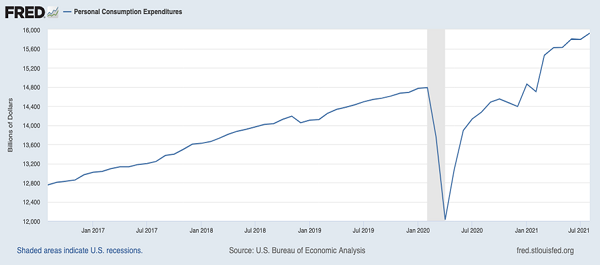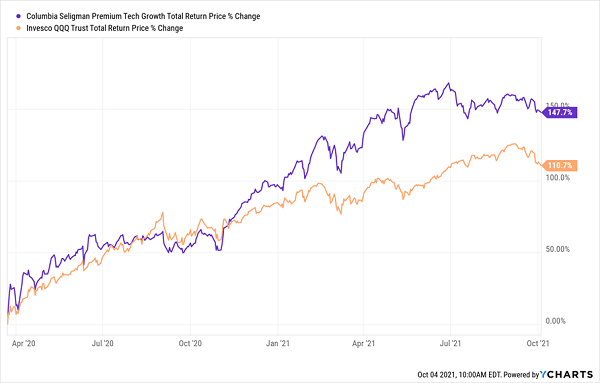Tech stocks have taken a header, and we contrarians are going to take advantage and set ourselves up for some serious upside—and 5.6% dividends, too.
Why are we zeroing in on tech now?
Because investors have been (wrongly) fretting over a 1970s-style inflation flare-up, and they’ve been (wrongly) taking it out on tech stocks over the last few weeks.
In a way, the selloff makes sense, as higher inflation, and the rising interest rates that come with it, cut into tech stocks’ profit growth—and investors look to tech mainly for that exceptional profit growth, which drives their share prices.
(Our favorite income plays, closed-end funds, or CEFs, let us take a different path, getting a big slice of our tech profits as cash dividends that we control, instead of less predictable price gains. We’ll discuss a top CEF option for buying this dip in a moment).
Our Tech-Buying Opportunity Arrives
How big of an opportunity do we have in front of us here?
As I write this, tech stocks, as measured by the performance of the Invesco QQQ Trust (NASDAQ:QQQ), (a benchmark for the tech-heavy NASDAQ, are about 7% off their September highs, which is broadly similar to the plunge they took in February and March.
That creates a nice entry point for us because the fears that caused the market dip back in March revolved around inflation. Back then, of course, inflation worries were fairly new, but today we understand a lot more about what’s happening on that front.
Sneak preview: fears about inflation’s effect on tech stocks (and tech-focused CEFs!) is way overblown, setting us up for some nice “bounce back” gains when investors realize they’ve gone too far to the downside.
To be sure, price increases are still with us: the Fed’s favorite inflation indicator rose to a 4.3% increase recently—more than twice the central bank’s target. And then there are things like rent, which clocked in at 15% higher than year-ago levels.
Inflation’s Rise Isn’t Quite What It Seems

But a lot of this is just a sign that things are returning to a degree of normalcy, not a long-term trend to a 1970s-type situation.
As you can see from the chart above, the recent acceleration in inflation is making price growth return to the pre-pandemic trend line. This means that, compared to 2020, yes, prices are rising sharply, but over the longer term, the story isn’t so dire.
And a closer look at the price gains we’re experiencing shows that a lot of fairly predictable things are happening. Take that 15% jump in rent I just mentioned. A big part of that is happening in large cities, to which some work-from-home employees are now returning. That’s driving up rents, though they’re still below pre-pandemic levels (Manhattan, for instance, is 3.2% below where it was pre-pandemic, according to real estate firm Douglas Elliman).
Of course, not everything is like it was before the pandemic; some parts of life have been changed forever. One such change is that some people are still working from home and still choosing to move to smaller cities. That’s why Boise, Idaho, has seen apartment-rental prices rise a whopping 40% from a year ago!
In short, a lot of things are changing very quickly in America. But the one thing that remains constant is the continued rapid expansion of technology in our lives.
How to Invest in Tech Now
Research firm McKinsey & Co. recently estimated that more than 20% of the workforce can do its job just as effectively by working from home three to five days a week as it could from the office. And with the cost savings and access to talent remote work offers employers, I think we can conservatively assume that this percentage of the workforce will continue to work at least part of their week outside their office in the long run.
In other words, even if demand for Internet-based services dips a bit in the coming months as some employees return to the office, the long-term trend is straight up—and that’s where our shot at high tech dividends, and growth, lie.
For example, this societal shift makes stocks like Zoom Communications (NASDAQ:ZM), Alphabet (NASDAQ:GOOGL), Amazon (NASDAQ:AMZN) and Microsoft (NASDAQ:MSFT) smart plays to buy on this dip and tuck away for decades. Because eventually investors will realize that inflation worries are a red herring when it comes to long-term tech profits, and they’ll buy back in.
And we have the opportunity to beat them to the punch—and do it with a nice 5.6% dividend (more than any of the above stocks pay on their own), too.
Our play here is the Columbia Seligman Premium Technology Growth Fund (NYSE:STK), a CEF that’s nicely tuned to this long-term dividend and growth opportunity. Its top holdings include Apple (NASDAQ:AAPL),Google and Microsoft, as well as other companies poised to benefit, like Visa (NYSE:V), cybersecurity firm Palo Alto Networks (NYSE:PANW) and NXP Semiconductors (NASDAQ:NXPI).
And how’s this for outperformance?
STK’s Management Shows Its Mettle

The best way to evaluate a fund’s management team is by looking at how it handles a crisis, and the year and a half we’ve just lived through provides the best testing ground we’ve seen since the 1930s.
As you can see, STK passed that test with flying colors, outrunning QQQ coming out of the March 2020 crash while providing a lot more dividend income than the benchmark ETF. (QQQ yields just 0.5%.) That’s a key reason why we love CEFs: they give you more of your return in cash, so you have a lot more control over your profits than an ETF like QQQ would give you.
What’s more, STK has never cut its dividend (and it’s even dropped two special dividends on shareholders in the last five years—a $0.78-a-share payout in December 2017 and $0.65 in January 2019), so you’re getting a nice cash stream for the long run, as well as the strong upside tech stocks are known for.
Disclosure: Brett Owens and Michael Foster are contrarian income investors who look for undervalued stocks/funds across the U.S. markets. Click here to learn how to profit from their strategies in the latest report, "7 Great Dividend Growth Stocks for a Secure Retirement."
